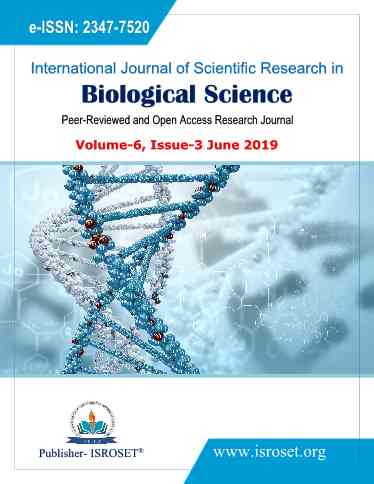Quality evaluation of Coconut Based Snack during storage period
Keywords:
Osmotic dehydration, coconuts, shelf life properties, impregnationAbstract
Natural versatile ingredients packed with potent nutrients such as beet root, carrot, ginger and mint have been selected for the recent study for their variable vast phenolic compounds and other functional properties as osmotic infusions in the form of filtrates. Sliced samples (0.8±0.1mm) of matured coconuts were subjected to the process osmotic dehydration from 0 min to 720 min at room temperature. Then the slices were dried in a hot-air oven at temperature 45-60°C for about 6-7 hours and freeze drying at temperature (-40 to 30°C) for a period of 14-16 hours. Osmotic medium without the infusion of filtrates of functional ingredients serves as the control. The snack samples were packed using Aluminium foil laminated LDPE pouches with infusion of 100% nitrogen gas composition and stored at ambient temperature till analyzing the shelf life features like free fatty acids, peroxide value, total sugars, moisture content and microbial growth and the results were interpreted using SPSS tool t test (p≤0.05). Upon three months of storage study, the products quality remained good, where as slight deterioration of shelf life characteristics seen beyond three months, showed the keeping quality of the snack.
References
Lathika, M., & Kumar, C. A. (2005). Growth trends in area, production and productivity of coconut in India. Indian Journal of Agricultural Economics, 60(4).
Madrau, M. A., Piscopo, A., Sanguinetti, A. M., Del Caro, A., Poiana, M., Romeo, F. V., & Piga, A. Effect of drying temperature on polyphenolic content and antioxidant activity of apricots. European Food Research and Technology, (2009), 228(3): 441-448.
Torreggiani, D. Osmotic dehydration in fruit and vegetable processing. Food Research International, (1993), 26(1): 59-68.
Alzamora, S. M., Salvatori, D., Tapia, M. S., López-Malo, A., Welti-Chanes, J., & Fito, P. Novel functional foods from vegetable matrices impregnated with biologically active compounds. Journal of Food Engineering, (2005). 67(1): 205-214.
Fito, P., Chiralt, A., Betoret, N., Gras, M., Cháfer, M., Martınez-Monzó, J., & Vidal, D. Vacuum impregnation and osmotic dehydration in matrix engineering: Application in functional fresh food development. Journal of Food Engineering, (2001), 49(2): 175-183.
Nicoletti, J. F., Telis-Romero, J., & Telis, V. R. N. Air-drying of fresh and osmotically pre-treated pineapple slices: Fixed air temperature versus fixed slice temperature drying kinetics. Drying Technology, (2001),19(9), 2175-2191.
Nieto, A., Salvatori, D., Castro, M. A., & Alzamora, S. M. (1998). Air drying behaviour of apples as affected by blanching and glucose impregnation. Journal of Food Engineering, 36(1): 63-79.
AOAC., Official Method of Analysis of the Official Analytical Chemist (25th Ed.). Virgin. (1990).
Meilgaard, M., Civile, G.V., and Carr, B.T. Sensory evaluation techniques, (2nd) Edition, 1991, 354.
Stone, H., & Sidel, J. L. (2004). Sensory evaluation practices. Academic press.
Rahman, M. S., & Lamb, J. (1990). Osmotic dehydration of pineapple. Journal of Food Science and Technology, 27(3): 150-152.
Ranganna S. (2000). Vitamins In Hand book of Analysis and Quality Control for Fruit and Vegetable Products. (2nd) edition. Tata McGraw Hill publishing Co.ltd, New Delhi, 113-117.
Harnkarnsujarit, N., & Charoenrein, S. (2011). Effect of water activity on sugar crystallization and β-carotene stability of freeze-dried mango powder. Journal of Food Engineering, 105(4): 592-598.
Negi, P. S., & Roy, S. K. (2001). Effect of drying conditions on quality of green leaves during long term storage. Food research international, 34(4): 283-287.
Dahiya, S., & Dhawan, S. S. (2003). Effect of drying methods on nutritional composition of dehydrated aonla fruit (Emblica officinalis Garten) during storage. Plant Foods for Human Nutrition, 58(3): 1-9.
Lee, S. K., & Kader, A. A. (2000). Preharvest and postharvest factors influencing vitamin C content of horticultural crops. Postharvest biology and technology, 20(3): 207-220.
Chang, C. H., Lin, H. Y., Chang, C. Y., & Liu, Y. C. (2006). Comparisons on the antioxidant properties of fresh, freeze-dried and hot-air-dried tomatoes. Journal of Food Engineering, 77(3): 478-485.
Choe, E., & Min, D. B. (2007). Chemistry of deep-fat frying oils. Journal of food science, 72(5): R77-R86.
Koczon, P., Gruczynska, E., & Kowalski, B. (2008). Changes in the acid value of butter during storage at different temperatures as assessed by Standard Methods or by FT-IR spectroscopy. American Journal of Food Technology, 3(3): 154-163.
Abascal, K., Ganora, L., & Yarnell, E. (2005). The effect of freeze-drying and its implications for botanical medicine: A Review. Phytotherapy Research, 19(8): 655-660.
Boran, G., Karaçam, H., & Boran, M. (2006). Changes in the quality of fish oils due to storage temperature and time. Food chemistry, 98(4): 693-698.
Downloads
Published
How to Cite
Issue
Section
License

This work is licensed under a Creative Commons Attribution 4.0 International License.
Authors contributing to this journal agree to publish their articles under the Creative Commons Attribution 4.0 International License, allowing third parties to share their work (copy, distribute, transmit) and to adapt it, under the condition that the authors are given credit and that in the event of reuse or distribution, the terms of this license are made clear.







